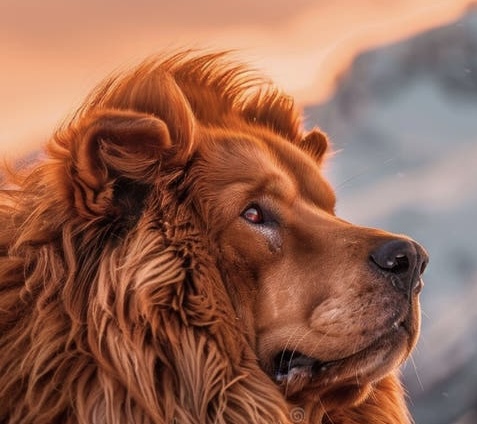In the realm of luxury possessions that signify wealth and status in modern China, one stands out not for its mechanical precision or precious metals, but for its ancient bloodline and majestic presence. The Tibetan Mastiff, once the humble guardian of Himalayan monasteries, has transformed into one of the most coveted status symbols among China’s elite, commanding prices that rival luxury cars and even modest homes.
Ancient Guardians of the Himalayas
The history of the Tibetan Mastiff stretches back thousands of years into the mists of time. These imposing canines evolved in the harsh, oxygen-thin environment of the Tibetan Plateau, where they served as protectors of nomadic camps, livestock, and sacred Buddhist monasteries. Known in Tibet as “Do-Kyi” (meaning “tied dog”), these massive guardians were often tethered at the gates of homes and temples they protected.
Early written accounts place large guardian dogs in China around 1100 B.C. The isolation of Tibet throughout much of history allowed the breed to develop without significant influence from Western breeding practices, preserving their unique characteristics and legendary resilience. Buddhist tradition holds that Tibetan Mastiffs possess the souls of monks and nuns who did not achieve entrance into Shambhala, the heavenly paradise.
Marco Polo encountered these magnificent beasts during his 13th-century travels, describing them as being “as large as a small donkey.” Their reputation for fierce loyalty and protective instincts made them invaluable companions in the unforgiving Himalayan landscape, where they defended their human families against predators both animal and human.
From Monastery Guards to Million-Dollar Status Symbols
The transformation of the Tibetan Mastiff from working dog to luxury commodity represents a fascinating intersection of ancient tradition and modern wealth. As China’s economic boom created a new class of ultra-wealthy individuals seeking distinctive ways to display their prosperity, the Tibetan Mastiff—with its imposing size, lion-like mane, and cultural significance—emerged as the perfect living status symbol.
The turning point came in the late 2000s, when prices for purebred Tibetan Mastiffs began to skyrocket. The market reached its zenith in 2014, when a golden-haired Tibetan Mastiff puppy sold for an astonishing $1.9 million at a luxury pet fair in Zhejiang province. The breeder, Zhang Gengyun, claimed the dog had “lion’s blood,” making it particularly valuable.
“They have lion’s blood and are top-of-the-range mastiff studs,” Zhang told reporters. The dog was 31 inches tall and weighed nearly 200 pounds, with the breeder comparing its value to that of “nationally treasured pandas.”
This wasn’t an isolated incident. A year earlier, a couple from Xi’an reportedly spent over $600,000 for a purebred Tibetan Mastiff named “Yangtze River 2,” using a fleet of Rolls Royces to transport their precious acquisition home. Such extravagant purchases reflect the unique position these dogs hold in Chinese culture and the contemporary luxury market.
Cultural Significance in Modern China
What drives the extraordinary demand for these massive canines? The answer lies in a complex blend of cultural reverence, superstition, and conspicuous consumption.
In Chinese culture, Tibetan Mastiffs are seen as holy animals that bring blessings to their owners. Their resemblance to lions—animals traditionally associated with power and prestige in Chinese iconography—enhances their appeal. The lion-like mane of the Tibetan Mastiff, particularly evident in the golden-red varieties, evokes the mythical guardian lions that stand watch outside imperial palaces and government buildings.
“The Tibetan mastiff is as treasured in China as the giant panda, so people consider it a symbol of higher social status,” explained one breeder to international media. This cultural significance, combined with their rarity and the difficulty of breeding them in captivity, created perfect conditions for their prices to soar.
Owning a Tibetan Mastiff in urban China is no small commitment. Dog licenses in major Chinese cities can cost over $100, and the registration process is notoriously bureaucratic. In Beijing, each dog must have photo identification, similar to its human owner. These barriers only enhance the exclusivity of Tibetan Mastiff ownership, further cementing their status as luxury possessions rather than mere pets.
The Reality Behind the Luxury
Despite their current status as living luxury items, Tibetan Mastiffs remain working dogs at heart. Bred for independence and protective instincts, they require experienced handling and are not suitable for typical urban living arrangements. Their thick double coats, evolved for the frigid Himalayan climate, make them poorly adapted to the heat and humidity of many Chinese cities.
The breed is known for being aloof with strangers while fiercely loyal to their families. As Martha Feltenstein, president of the American Tibetan Mastiff Association, notes: “Not all TMs will be friendly to strangers, and not all will let a stranger into their home.” This temperament, while perfect for their original guardian role, presents challenges for owners who acquire them primarily as status symbols without understanding their needs.
The Tibetan Mastiff boom has also raised concerns about breeding practices. The astronomical prices have incentivized irresponsible breeding focused on exaggerated features like massive size and excessive coat, sometimes at the expense of health and temperament. Animal welfare advocates worry about the fate of these dogs when they no longer serve their purpose as status symbols or when owners realize they cannot manage such a powerful breed.
The Future of China’s Canine Crown Jewel
The market for ultra-expensive Tibetan Mastiffs has cooled somewhat since its peak, with prices stabilizing as the novelty factor diminishes. However, these magnificent dogs continue to command respect and admiration both in their homeland and internationally. The American Kennel Club officially recognized the breed in 2006, placing it in the Working Group.
For those who truly appreciate the Tibetan Mastiff for its historical significance, protective nature, and majestic appearance—rather than merely as a status symbol—these dogs represent a living connection to ancient traditions. Their journey from the remote monasteries of Tibet to the luxury pet shows of modern China tells a story not just about changing canine fortunes, but about the evolving values and aspirations of human society.
Whether guardian or status symbol, the Tibetan Mastiff remains an impressive testament to the ancient bond between humans and dogs, adapted to new cultural contexts while carrying the genetic legacy of its mountainous homeland. In a rapidly changing China, these living emblems of tradition and luxury continue to find their place—one that increasingly balances their historical purpose with their contemporary cultural significance.


